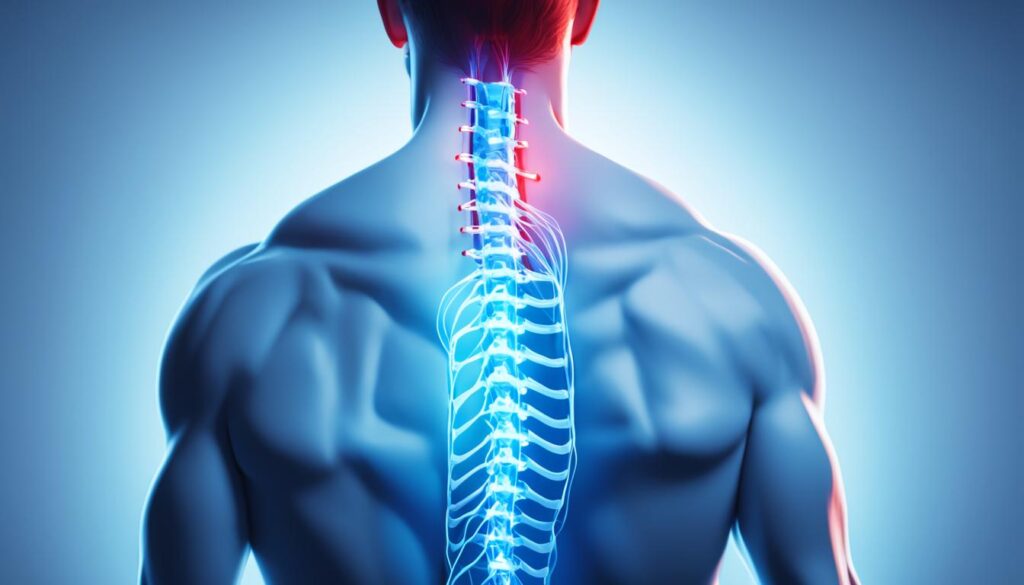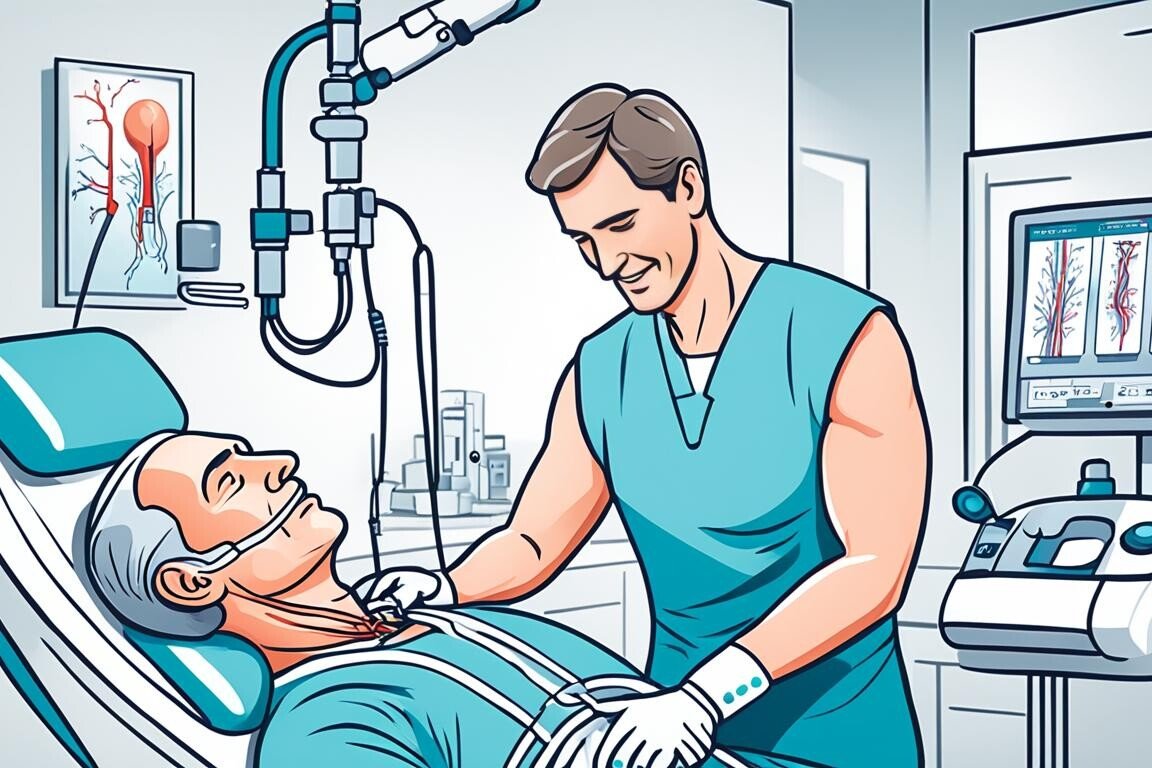If you’re one of the millions struggling with chronic pain, you know how tough it can be. Traditional pain management options often have side effects and can lead to addiction, especially with opioids. But, there’s a safer, more effective way – interventional pain treatments.
These treatments go right to the source of your pain, offering relief without lots of medication. Procedures like spinal injections, nerve blocks, and radiofrequency ablation are minimally invasive. They can give you quick, lasting pain relief. By tackling the root causes of your pain, you can improve your life and cut down on addictive drugs.
One big plus of interventional pain treatments is they help you avoid opioids. The opioid crisis is a big problem, causing many deaths from overdoses. These treatments offer a safer way to manage pain, without the risks of addiction and other side effects of opioids.
If you’re fed up with chronic pain and traditional treatments aren’t helping, think about interventional pain management. With targeted, less invasive procedures, you can find lasting relief. This way, you can get back to living the life you want.
Table of Contents
ToggleWhat is Interventional Pain Treatment?
Interventional pain treatment is a type of care that uses less invasive methods to tackle chronic pain at its source. It includes things like targeted injections and nerve stimulation. These methods help reduce pain with fewer side effects than traditional painkillers. The aim is to give precise relief where it’s needed most.
Minimally-Invasive Approach
These treatments use a gentle approach, focusing on specific areas with techniques like injections and radiofrequency ablation. This way, patients can get relief without the risks of major surgery or dangerous drugs.
Targeted Pain Relief
- These methods target the root of pain to offer relief.
- They include treatments like epidural steroid injections and nerve blocks. These aim to lessen inflammation and enhance function in certain areas.
- The ultimate goal is to boost the patient’s life quality by managing chronic pain with these interventional pain treatment options.

Address Pain at the Source
Interventional pain treatments aim to find and fix the main cause of your chronic pain. They don’t just cover up the symptoms. These treatments use precise injections and procedures to target the exact spot of your pain. This method leads to more effective and lasting relief from pain.
Interventional pain management techniques can include:
- Epidural steroid injections that reduce inflammation and pain in the spine and radiating limbs in just 5 minutes
- Medial branch blocks and facet joint injections that provide targeted relief for back and neck pain in about 5 minutes
- Radiofrequency nerve ablations that can offer 6-12 months of pain relief for chronic low back or neck pain in a 20-minute procedure
- Joint injections that can alleviate pain from degenerative joint diseases like arthritis for several months in just 2 minutes
- Occipital nerve blocks that can relieve chronic headaches and migraines for several months in about 30 seconds
By addressing pain at the source with these targeted pain relief techniques, interventional pain management can give you lasting comfort and improve your quality of life.
Reduced Dependence on Opioids
Many people with chronic pain use opioids to feel better. But these drugs can be addictive and have serious side effects. Interventional pain treatments are a safer choice, helping you manage pain without the risks of opioid addiction.
Safer Alternative
These treatments focus on the pain source directly. They offer relief without the need for opioids over time. This way, you can cut down on addictive drugs and avoid health risks from opioids.
Lower Risk of Addiction
Opioid addiction is a big problem, with over 2 million Americans misusing them and nearly 90 daily overdose deaths. Interventional pain treatments let you handle chronic pain safely, without the high risk of addiction. This is a safer, more lasting way to manage pain.

By targeting pain at its source with minimally invasive procedures, these treatments can reduce your need for opioids. This leads to safer pain management and a lower risk of addiction. It gives you more control over your health and improves your life quality.
Quick and Effective Relief
Interventional pain treatments are a fast way to relieve pain and manage it well. They are less invasive and go right to the source of pain. This means they work faster than pills, which can take a while to kick in.
These treatments include things like trigger point injections, nerve blocks, and epidural steroid injections. They stop pain signals before they reach the brain. They also reduce inflammation and ease muscle knots that cause pain.
- Trigger point injections help with myofascial pain by treating several trigger points at once.
- Nerve blocks use local anesthetics to ease pain from issues like bursitis and joint problems.
- Epidural steroid injections help with lower back pain and can also help with upper back and neck pain.
These treatments are usually safe but can have risks like infection or bleeding. They need special skills to do right, which might make them hard to get. But for many, the fast and effective relief they offer is worth it.
By targeting the source of pain, people can see a big improvement in their lives. They can do their normal activities again and feel independent. This approach to managing pain can be a big change for those looking for a quick and lasting fix.

Long-Lasting Pain Management
Managing chronic pain can be tough, but treatments like radiofrequency ablation and spinal cord stimulation can help a lot. These methods target the pain source, stopping pain signals before they reach your brain. They offer relief that can last for months or even years, unlike pain meds that only help for a short time.
Radiofrequency Ablation
Radiofrequency ablation is a simple procedure that uses electrical currents to block pain signals from nerves. It aims at the pain source, giving you lasting relief for things like chronic back, neck, or joint pain.
Spinal Cord Stimulation
Spinal cord stimulation is another way to manage pain. It involves putting in a small device that sends electrical currents to the spinal cord. This helps reduce your pain significantly, giving you long-lasting pain relief.

These interventional pain management methods can really change lives for people with chronic pain. They tackle the root of your pain, leading to long-term relief and a better life.
Minimally or Non-Invasive Options
Many treatments for chronic pain offer non-surgical options. These treatments can be done outside the hospital. They help pain patients find relief without major surgery and its risks.
Outpatient Procedures
Some pain management methods, like injections and nerve blocks, can be done without staying in the hospital. These minimally invasive pain treatments are done on an outpatient basis. They use advanced imaging to make sure the pain relief is accurate and effective.
Avoid Invasive Surgeries
Choosing non-invasive pain management can help avoid risky surgeries. These treatments target the pain source directly. This way, patients can find comfort without complex surgeries.
Thanks to minimally invasive pain treatments and outpatient procedures, interventional pain management is a good choice. It helps people avoid invasive surgeries and get lasting relief from chronic pain.

Interventional Pain Management Techniques
Interventional pain management uses many techniques to tackle chronic pain at its root. These methods go beyond just easing symptoms. They aim for targeted, lasting relief for those in pain.
Some top techniques include:
- Medication management, where doctors tailor medicines to fit the patient’s needs for the best pain relief with fewer side effects.
- Image-guided injections, like epidural steroid injections, nerve blocks, and joint injections, which target specific pain areas.
- Physical therapy, which boosts mobility, strength, and function to lessen pain and enhance life quality.
- Minimally invasive surgeries, such as radiofrequency ablation and spinal cord stimulation, for chronic pain management.
- Regenerative medicine techniques, including stem cell therapy and platelet-rich plasma injections, which help the body heal naturally.
These techniques often work together in a personalized plan. They focus on the pain’s source, not just its symptoms. This approach can lead to lasting relief and better life quality for those with chronic pain.

Fewer Side Effects
Interventional pain treatments are a better choice for chronic pain than traditional pain pills. They have fewer side effects. Pills can cause constipation, vomiting, nausea, and dizziness. But, interventional treatments are safer and easier for patients.
Chronic pain affects nearly 20% of Americans. Opioids help with pain but have many side effects. This leads to less use. Interventional pain management helps many people manage chronic pain for years with fewer side effects.
- Minimally invasive techniques in pain management can replace risky surgeries like joint replacements. This lowers the risk of side effects.
- Pain management treatments target pain at its source. This means relief without affecting the whole body or brain. So, there are fewer side effects than with traditional meds.
- These methods can cut down on the need for long-term pain meds. This reduces side effects and the risk of becoming dependent.
Choosing interventional pain treatments helps chronic pain sufferers find relief with fewer side effects. This improves their quality of life and overall well-being.

Interventional Pain Treatments
Interventional pain treatments can change the game for chronic pain sufferers. These procedures are designed to find and fix the source of pain. They offer quick and lasting relief. From epidural steroid injections for back and neck pain, to nerve blocks and joint injections, these treatments cover a wide range of chronic pain issues.
Epidural Steroid Injections
Epidural steroid injections help with lower back and neck pain. They’re used for conditions like arthritis, herniated discs, or spinal stenosis. The medication goes right to the pain spot, offering targeted relief and possibly cutting down on the need for pills.
Nerve Blocks
Nerve blocks stop pain signals from reaching the brain. They’re great for people with nerve pain, complex regional pain syndrome, or other nerve issues. These treatments can make a big difference for those in pain.
Joint Injections
Joint injections are a less invasive way to ease pain in knees, hips, or other joints. They help reduce inflammation and ease pain. This can be a good option instead of surgery.
If you’re dealing with back, neck, or joint pain, consider interventional pain treatments. They aim to fix the underlying cause of pain. This can help you take back control of your life.
Regenerative Therapies
Interventional pain management specialists are now using regenerative therapies to help with chronic pain. These treatments work by helping the body heal itself. They focus on the root causes of pain, not just the symptoms.
Therapies like platelet-rich plasma (PRP) injections and stem cell therapy use the body’s own cells to heal. PRP comes from the patient’s blood and is injected into the painful area. Stem cell therapy uses cells that can turn into different types, like blood, nerve, or muscle cells.
- Regenerative therapies stimulate the body’s natural healing processes to address the root causes of chronic pain.
- PRP injections utilize the patient’s own platelet-rich plasma to promote tissue regeneration.
- Stem cell therapy employs the body’s repair systems to regenerate damaged or diseased cells.
These treatments are great for chronic pain in joints, muscles, and discs. They help fix the underlying problems, offering lasting relief and better quality of life.
Specialists in interventional pain management create personalized treatment plans. They might include regenerative therapies and other methods. This way, they aim to give the best relief for chronic pain, cutting down on opioids and other harmful drugs.
Comprehensive Pain Management
Managing chronic pain often requires a comprehensive approach. At top interventional pain treatment centers, a team of experts works together. This team includes anesthesiologists, physical therapists, psychologists, and more.
This team creates a personalized treatment plan. It looks at the physical, emotional, and lifestyle factors that cause pain. This way, treatment is more effective and can reduce the need for surgery or opioid use.
At these centers, interventional pain treatment options like nerve ablation and targeted injections are used. These methods are safe and don’t involve major surgery. They help patients find relief from chronic pain and improve their life quality.
Using a multi-disciplinary approach, these centers lead in treating chronic pain. They combine advanced therapies with teamwork. This helps patients take charge of their recovery and live better lives.
Improve Quality of Life
Chronic pain can really take a toll on someone’s life. Interventional pain treatments offer hope to those in constant discomfort. These treatments target the pain’s root, giving lasting relief and helping patients live fully again.
With interventional pain management, people with chronic pain see big improvements in their lives. Procedures like nerve blocks and radiofrequency ablation work directly on the pain source. This reduces pain and boosts physical function, letting patients enjoy daily activities and hobbies without pain.
- These treatments can ease pain from arthritis, nerve damage, and inflammation, making it easier to move around and stay active.
- Methods like spinal cord stimulation and intrathecal drug delivery help those with neuropathic pain or after failed back surgery.
- They can also cut down on the need for opioids, lowering the risk of addiction and side effects.
Interventional treatments give patients better control over their chronic pain. This leads to better physical health, less need for pain meds, and the chance to do more in life. The aim is to help people be more independent and live a life full of joy and activity.
The Way Forward
Understanding and treating chronic pain is changing, and interventional pain management is becoming key. It uses less invasive methods and aims to cut down on opioids. This approach offers hope for those with chronic pain.
The future of treating chronic pain is exciting, thanks to new tech and a better grasp of pain causes. Wearable devices, virtual reality therapy, and targeted treatments are changing how we handle chronic pain.
The opioid crisis is making us look for safer pain relief options. Interventional pain management is vital in this effort. It helps patients lessen their opioid use and find therapies that get to the heart of their pain.
Personalized medicine is also promising for chronic pain treatment. By using genetic tests and pharmacogenomics, doctors can make treatments that fit each patient better. This means better results and fewer side effects.
For the future, treating chronic pain will need a team effort. This means combining interventional treatments, physical therapy, support, and new therapies. Together, they can offer lasting relief to those with chronic pain.
The world of chronic pain treatment and interventional pain management is growing. With new advances and a focus on patient care, we can help people improve their lives. This leads to effective, long-lasting pain relief.
Conclusion
Interventional pain treatments offer many benefits for those with chronic pain in India. They provide targeted relief and help reduce opioid use. These treatments are quick and can last a long time, improving your life quality.
They focus on the root causes of pain and use a team approach. This makes them key in helping people with chronic pain find lasting relief.
The research shows these treatments are safe and effective. Even though there are risks, the benefits are usually greater. As research grows, we’ll see more new and tailored ways to fight chronic pain.
If you have chronic pain, like complex regional pain syndrome or low back pain, consider interventional treatments. Talk to your doctor about what options you have. With the right treatment, you can manage your pain better and improve your life.
FAQ
What are the benefits of interventional pain treatments for chronic pain sufferers?
What is interventional pain treatment?
How do interventional pain treatments work?
How do interventional pain treatments reduce dependence on opioids?
How quickly can interventional pain treatments provide relief?
How long-lasting are the effects of interventional pain treatments?
Are interventional pain treatments minimally or non-invasive?
What types of interventional pain management techniques are available?
Do interventional pain treatments have fewer side effects than traditional pain medications?
What are some common interventional pain treatments?
How do regenerative therapies fit into interventional pain management?
How does the multi-disciplinary approach benefit interventional pain management?
How can interventional pain treatments improve quality of life for chronic pain sufferers?
What is the future outlook for interventional pain management?
The future looks promising for treating chronic pain with interventional methods. With a focus on minimally invasive techniques and reducing opioid use, it offers hope for those with chronic pain.
Source Links
About The Author

This article is medically reviewed by Dr. Chandril Chugh, Board-Certified Neurologist, providing expert insights and reliable health information.
Dr. Chandril Chugh is a U.S.-trained neurologist with over a decade of experience. Known for his compassionate care, he specializes in treating neurological conditions such as migraines, epilepsy, and Parkinson’s disease. Dr. Chugh is highly regarded for his patient-centered approach and dedication to providing personalized care.
→ Book a consultation to discover which remedies suit your needs best.




